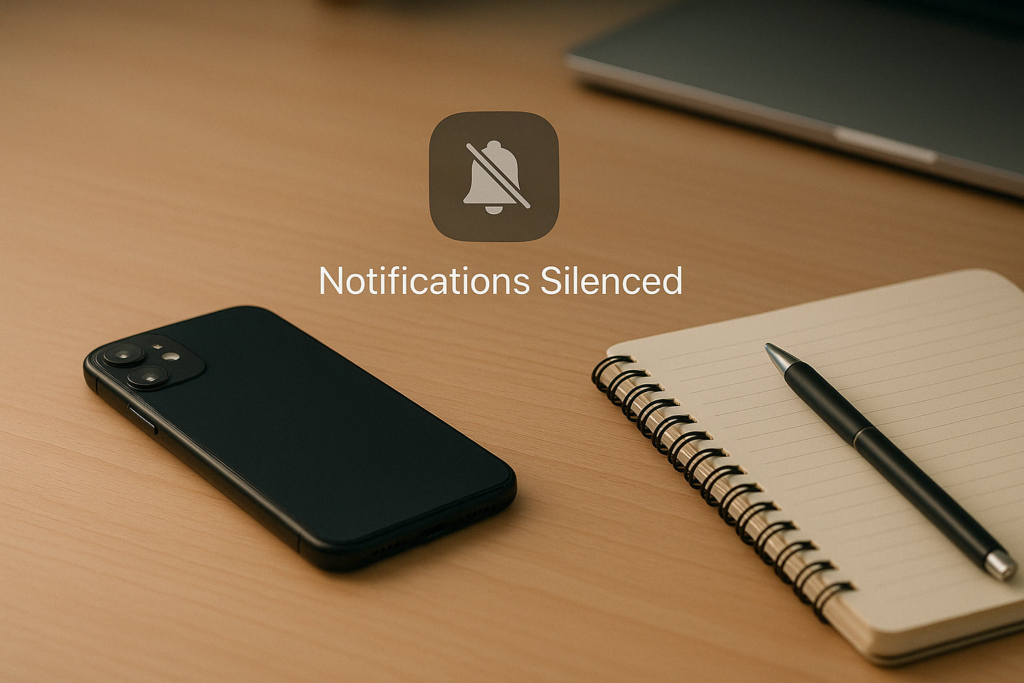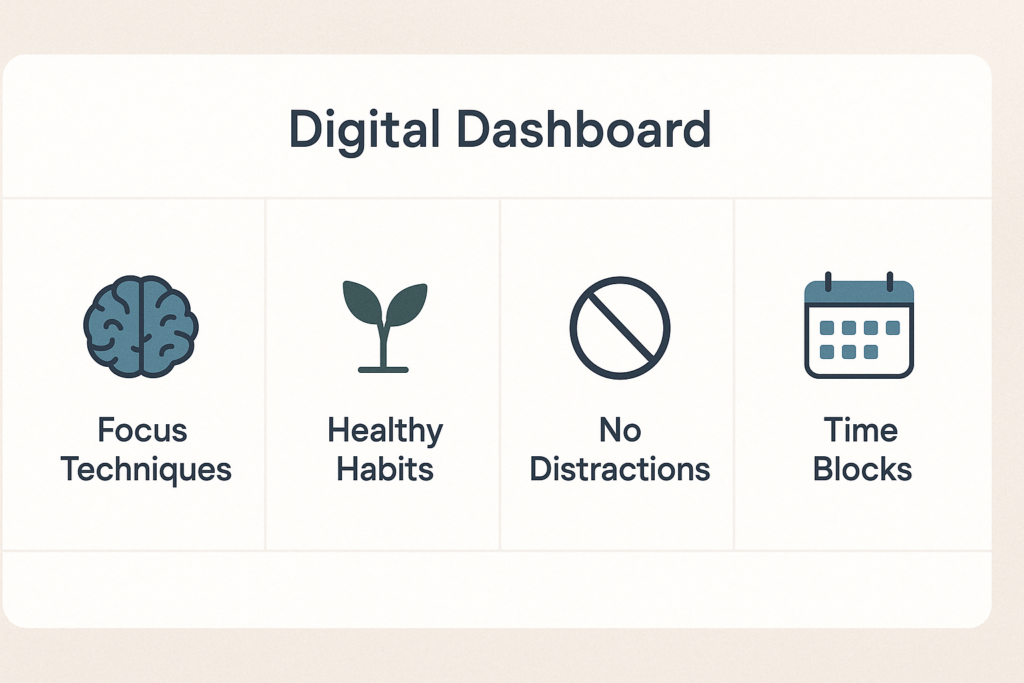Ever feel like your brain has too many tabs open? You sit down determined to tackle that important work project, dive into your studies, or simply enjoy a good book, and suddenly… poof! Your focus vanishes. You find yourself checking emails for the tenth time, mindlessly scrolling through social media, or just staring blankly, wondering where the last hour went. If this sounds familiar, you’re definitely not alone. In our hyper-connected world, staying focused feels harder than ever.
But what exactly is concentration? Think of it as the ability to direct your mental spotlight exactly where you want it to go, highlighting the task at hand while letting other thoughts fade into the background. It’s about focusing your attention deliberately. The good news? Concentration isn’t some fixed trait you either have or don’t; it’s a skill, and like any skill, it can be practiced and significantly improved.
It’s true that modern life throws a lot at our attention spans. We’re constantly bombarded by digital notifications designed to grab our focus, often feel pressured to juggle multiple things at once (hello, multitasking myth!), and deal with everyday stress that can cloud our minds. It’s easy to feel scattered.
However, regaining control over your focus doesn’t require superhuman willpower or complicated strategies. This guide will walk you through simple, practical, and genuinely easy ways to minimize distractions, train your brain, and build habits that support sustained concentration. Let’s find your focus mode, starting today!

Clear Your Space, Clear Your Mind: Taming External Distractions
Have you ever noticed how hard it is to think clearly when your desk looks like a tornado hit it? There’s a reason for that. Our physical environment plays a huge role in our ability to concentrate. A cluttered space often contributes to a cluttered mind, and external distractions – the noises, sights, and digital pings around us – constantly compete for our mental spotlight. Taming these external factors is the first step towards better focus.

Practical Step 1:
Declutter Your Physical Workspace Take a look around your immediate workspace. Piles of paper, random objects, even too many trinkets can create visual noise that subtly pulls at your attention.
- Action: Spend just 5 minutes at the beginning or end of your focus session tidying up. Put away items not related to your current task. A cleaner, more organized space reduces potential distractions and sends a calming signal to your brain.
- Example: Clear everything off your desk except your laptop, a notebook, and a pen. Move that pile of unrelated papers out of your line of sight.
Practical Step 2:
Find or Create Quiet Noise is one of the most common focus-killers. Constant chatter, background TV, or construction sounds can keep your mind on high alert.
- Action: If possible, find a quiet room or corner to work or study. If that’s not an option, create your own “focus bubble.” Noise-canceling headphones are a great investment. Alternatively, use apps or websites (like Noisli) that play background sounds like white noise, rain, or ambient coffee shop sounds to mask jarring noises.
- Example: Working from a busy home? Pop in some earbuds playing gentle rain sounds or use noise-canceling headphones, even if you’re not listening to music, to signal to others (and yourself) that you’re in focus mode.

Practical Step 3:
Master Your Digital Environment (Digital Hygiene Basics) Our digital devices are perhaps the biggest source of modern distraction. Taming them is crucial.
- Action 1: Tame Notifications. Those little pings and pop-ups are specifically designed to hook your attention. Be ruthless! Turn off all non-essential notifications on your phone, computer, and tablet. This includes alerts from social media, news apps, and most emails. Consider putting your phone on silent mode, turning it facedown, or even placing it in another room during dedicated focus periods.
- Action 2: Schedule Tech Checks. Resist the urge to constantly check email or social media feeds. This constant switching fragments your attention. Instead, schedule specific, short blocks of time for these activities. For example, check and respond to emails for 20 minutes at 10 am and again at 3 pm, rather than reacting to every incoming message.
- Action 3: Curate Your Digital Space. Just like decluttering your desk, declutter your digital workspace. Uninstall apps you rarely use or find particularly distracting. Consider using website blocker apps or browser extensions during work periods. Basic cyber hygiene, like using strong, unique passwords and enabling two-factor authentication, can also reduce background anxiety about security, freeing up mental space.
- Example: Turn off all notifications except calls from family. Put your phone in a drawer while working on an important report. Schedule two 20-minute “email batching” sessions per day.

Why This Works:
It’s not just about avoiding annoyance. Research shows that even the mere presence of your smartphone nearby can drain your cognitive resources, as part of your brain is actively working to resist picking it up – a phenomenon called the “brain drain” effect. Furthermore, every interruption, no matter how small, comes with a significant time cost. Studies indicate it can take upwards of 20-25 minutes to fully regain your concentration after being distracted.
It’s also helpful to understand that the constant pull of digital devices isn’t entirely a matter of personal willpower. Many apps and platforms are intentionally designed using psychological principles to capture and hold our attention, creating “attention hooks” that trigger our reactive systems. Recognizing this helps shift the focus from blaming ourselves to implementing proactive strategies. Creating systems – like turning off notifications or scheduling tech checks – is about managing the environment to support focus, rather than relying solely on resisting temptation in the moment.
Train Your Brain: Simple Techniques for Deep Focus
Once you’ve minimized external distractions, the next step is to train your brain to concentrate more effectively. This involves understanding how focus works and using simple techniques to strengthen your attention “muscle.”
Busting the Multitasking Myth First, let’s address a common misconception: the idea that multitasking makes us more productive. While we might feel busy juggling emails, calls, and project work simultaneously, our brains aren’t actually doing these things at the same time. When tasks require thinking (cognitive effort), our brains can only truly focus on one at a time. What feels like multitasking is actually rapid “task-switching”.
Each time we switch, we incur a “switch cost” – a small delay and loss of mental energy as our brain disengages from one task and re-engages with another. These costs add up quickly, leading to reduced efficiency, more errors, increased stress, and shallower thinking. Productivity experts like Dave Crenshaw argue that multitasking is a myth, a lie that actively damages productivity. Fundamentally, our brains perform best on focused tasks when they operate in single-task mode.

Practical Technique 1:
Embrace Single-Tasking The antidote to multitasking is single-tasking: dedicating your full attention to one specific task until it’s completed or you reach a planned stopping point.
- Action: Consciously choose to work on only one thing at a time. If other tasks or ideas pop into your head, quickly jot them down to address later, then return your focus to the primary task.
- Benefit: Single-tasking reduces the cognitive load on your brain, allowing for deeper focus, higher quality work, and less mental fatigue. It often leads to completing tasks more quickly and effectively, while also reducing stress.
- Example: Instead of trying to draft a report while half-listening to a podcast, dedicate a block of time solely to writing the report. Listen to the podcast during a break or commute later.
Practical Technique 2:

The Pomodoro Technique Developed by Francesco Cirillo, this popular time management method uses timed intervals to promote focus and prevent burnout.
- Action: Follow these simple steps:
- Choose one specific task to work on.
- Set a timer for 25 minutes (this is one “Pomodoro”).
- Work only on that task, ignoring distractions until the timer rings. If a distraction pops up (an idea, another task), jot it down quickly and return to your Pomodoro task.
- When the timer rings, take a short break (around 5 minutes). Step away from your work – stretch, get water, look out the window.
- After completing four Pomodoros, take a longer break (15-30 minutes).
- Benefit: The Pomodoro Technique breaks large tasks into manageable chunks, creates a sense of urgency, forces regular breaks (which are crucial for sustained focus), and provides a structure for dealing with interruptions.
- Example: Need to study a dense textbook chapter? Break it down. Do one 25-minute Pomodoro reading and taking notes, take a 5-minute stretch break, then do another Pomodoro summarizing the key points.
Practical Technique 3:
Time Blocking & Task Batching These methods involve structuring your day to dedicate specific times to specific activities.
- Action:
- Time Blocking: Look at your to-do list and schedule specific blocks of time in your calendar for each significant task or project. Treat these blocks like appointments.
- Task Batching: Group similar, often smaller, tasks together and schedule a single block to tackle them all at once. This reduces the mental friction of switching between different types of work.
- Benefit: These techniques provide a clear structure for your day, protect time for important “deep work,” make you more conscious of how you spend your time, help combat procrastination by assigning start times, and minimize inefficient context switching.
- Example: Block out 9:00 AM – 10:30 AM for “Write Marketing Proposal” (Time Blocking). Schedule a 30-minute block at 4:00 PM for “Admin Batch” where you answer emails, return phone calls, and file expense reports (Task Batching).
Practical Technique 4:
Quick Mindfulness Moments Mindfulness isn’t about emptying your mind; it’s about paying attention to the present moment without judgment. Even brief exercises can significantly boost focus.
- Action: Try one of these simple practices:
- Focused Breathing: Sit comfortably, close your eyes or soften your gaze. Simply notice the sensation of your breath entering and leaving your body. When your mind wanders (which it will!), gently acknowledge the thought and guide your attention back to your breath. Try this for just 1-2 minutes.
- 5-4-3-2-1 Grounding: Quickly engage your senses wherever you are. Silently name: 5 things you can see, 4 things you can physically feel (your feet on the floor, the chair beneath you), 3 things you can hear, 2 things you can smell, and 1 thing you can taste.
- Benefit: Mindfulness practices act like strength training for your brain’s attention networks, particularly the prefrontal cortex which helps regulate focus. They help you become more aware of when your focus drifts and strengthen your ability to gently redirect it. Even short moments can reduce stress and reset your concentration.
- Example: Feeling scattered between meetings? Take 60 seconds for focused breathing. Overwhelmed by your to-do list? Quickly run through the 5-4-3-2-1 exercise to ground yourself in the present.
Quick Guide: Focus Techniques at a Glance
Importantly, these techniques are skills, not magic wands. Their effectiveness grows with consistent practice. Don’t be discouraged if they feel awkward at first. The key is to experiment and find what works best for you and the specific task at hand. Maybe 25-minute Pomodoros feel too short or too long – adjust the timing. Perhaps Time Blocking feels too rigid initially – start by blocking just one or two key tasks. Treat it like learning any new skill: start small, practice regularly, and adapt as you go. This active experimentation and consistent effort are what truly build lasting focus.
Fuel Your Focus Engine: Everyday Habits That Make a Difference
Improving concentration isn’t just about techniques you use while working; it’s deeply connected to your overall well-being. Your brain is part of your body, and its ability to focus is profoundly influenced by fundamental lifestyle habits. Think of these daily practices as building a strong, reliable foundation upon which your focus can stand. Neglecting them makes concentration an uphill battle, no matter what techniques you try.

Practical Habit 1:
Prioritize Sleep Sleep isn’t a luxury; it’s a biological necessity for cognitive function.
- Action: Aim for the recommended 7-8 hours of quality sleep per night for adults. Establish a consistent sleep schedule, going to bed and waking up around the same time each day, even on weekends. Create a sleep-conducive environment: keep your bedroom cool, dark, and quiet. Avoid screens (phones, tablets, TVs) for at least an hour before bed, as the blue light can interfere with sleep signals.
- Benefit: Sleep deprivation directly impairs attention, working memory, decision-making, and learning. During sleep, your brain consolidates memories and clears out metabolic waste products that can hinder thinking. Quality sleep is essential for waking up refreshed and ready to focus.
- Example: Set a consistent bedtime alarm (not just a wake-up alarm!). Use blackout curtains or an eye mask if needed. Read a physical book instead of scrolling on your phone before sleep.
Practical Habit 2:
Hydrate for Clarity Your brain is about 75% water, and it needs adequate hydration to function optimally.
- Action: Keep a water bottle handy throughout the day and sip regularly. General guidelines suggest around 8-11 cups (2-2.7 liters) of fluids daily for women and 10-15 cups (2.5-3.7 liters) for men, but individual needs vary based on activity level, climate, and health. Don’t wait until you feel thirsty; thirst is often a sign that you’re already slightly dehydrated.
- Benefit: Even mild dehydration can impair cognitive functions like attention, executive function (planning and problem-solving), and motor coordination. It can also negatively affect mood and make your brain work harder just to perform tasks. Staying properly hydrated supports clearer thinking and sustained focus.
- Example: Start your day with a glass of water. Refill your water bottle during breaks. Choose water over sugary drinks.
Practical Habit 3:
Choose Brain-Boosting Foods What you eat directly fuels your brain. While there’s no single “magic” food, a balanced diet rich in certain nutrients supports cognitive health.
- Action: Focus on whole, unprocessed foods. Include sources of omega-3 fatty acids (found in oily fish like salmon and tuna, walnuts, flaxseeds), antioxidants (abundant in berries, dark chocolate), vitamin E (nuts and seeds), and B vitamins (whole grains, eggs). Cruciferous vegetables like broccoli contain compounds beneficial for brain health. Don’t skip breakfast, as studies show it can improve short-term memory and attention. Limit sugary snacks and drinks, which can lead to energy crashes and impair concentration.
- Benefit: Omega-3s are crucial for building brain cell membranes and improving blood flow. Antioxidants protect brain cells from damage. Stable blood sugar levels provide consistent energy, preventing the focus-killing slumps that follow sugar highs. Nutrients like choline (in eggs) support neurotransmitter function.
- Example: Add berries and nuts to your breakfast oatmeal. Have salmon or tuna twice a week. Snack on dark chocolate (in moderation!) or a handful of almonds instead of candy.
Practical Habit 4:
Move Your Body Physical activity is as good for your brain as it is for your body.
- Action: Aim for regular physical activity. This doesn’t mean you need to run marathons; moderate-intensity exercise like brisk walking, swimming, dancing, cycling, or even gardening provides significant benefits. Activities like yoga and tai chi also incorporate elements of focus and mindfulness. Even short bursts of movement throughout the day help.
- Benefit: Exercise increases blood flow to the brain, delivering vital oxygen and nutrients. It helps reduce stress, improve mood, and has been shown to enhance cognitive functions including memory, planning, and the ability to multitask (ironically, by strengthening the brain’s underlying processing capabilities).
- Example: Take a brisk 15-minute walk during your lunch break. Do a few minutes of stretching every hour if you sit for long periods. Find an activity you enjoy, whether it’s dancing, cycling, or yoga.
Practical Habit 5:
Take Effective Breaks Working non-stop is counterproductive. Your brain needs downtime to recharge and consolidate information.
- Action: Take regular, purposeful breaks. Stepping away from one screen only to stare at another (like scrolling social media) often isn’t truly restorative. Instead, use breaks to move your body (stretch, walk), rest your eyes, listen to music, meditate briefly, chat with a colleague (offline), tidy your space, or simply do nothing for a few minutes. The Pomodoro Technique has built-in short breaks for this reason.
- Benefit: Breaks combat cognitive fatigue and prevent burnout. They allow your brain to shift into its “diffused mode” of thinking, which is crucial for creativity, insight, and problem-solving. Taking breaks reduces stress and helps you return to your task with renewed energy and focus.
- Example: During your 5-minute Pomodoro break, stand up, stretch, and walk to get a glass of water. After a longer work block, take a 15-minute walk outside if possible.

The Foundation for Focus:
It’s crucial to recognize that these lifestyle factors aren’t just helpful extras; they are often the root cause of concentration problems. Trying complex focus techniques without addressing poor sleep, dehydration, inadequate nutrition, lack of movement, or chronic fatigue is like trying to build a house on shaky ground. Getting these fundamentals right often provides the biggest boost to your ability to concentrate.
Furthermore, these habits are interconnected and create positive feedback loops. When you sleep better, you have more energy to exercise and manage stress. When you eat well, your mood and energy levels are more stable. Staying hydrated prevents fatigue, and taking regular breaks makes focused work more sustainable. Improving one area often makes it easier to improve others, creating an upward spiral that supports overall cognitive function and makes achieving focus feel much less effortful.
Your Easy Focus Toolkit: Key Takeaways
Feeling overwhelmed by distractions and struggling to concentrate is a common experience in today’s world, but it’s not something you just have to accept. Improving your focus is achievable with simple, practical strategies that you can easily weave into your daily life.

Let’s quickly recap the main pillars of your easy focus toolkit:
- Optimize Your Environment: Tidy your physical workspace and minimize noise. Crucially, take control of your digital world by silencing non-essential notifications and scheduling time for email and social media checks.
- Use Simple Focus Techniques: Ditch the myth of multitasking and embrace single-tasking. Experiment with methods like the Pomodoro Technique (short bursts of focused work with breaks) or Time Blocking/Task Batching (scheduling specific tasks into your day). Incorporate quick mindfulness moments to train your attention.
- Build Foundational Lifestyle Habits: Prioritize getting enough quality sleep. Stay hydrated throughout the day. Fuel your brain with a balanced diet. Move your body regularly. And take purposeful breaks away from your screens to rest and recharge.
Remember, these are easy-to-implement strategies. The goal isn’t to perfectly execute every single tip overnight, but to make small, consistent progress. Concentration, like any skill, strengthens with practice. Consistency beats intensity every time.
So, what’s one small step you can take today? Maybe it’s turning off social media notifications for the next hour. Perhaps it’s trying one 25-minute Pomodoro session. Or maybe it’s simply drinking an extra glass of water or taking a 5-minute stretch break right now.
Pick one thing. Try it. See how it feels. You have the power to manage distractions and sharpen your focus. You’ve got this! Take back your concentration, one simple, easy step at a time.

